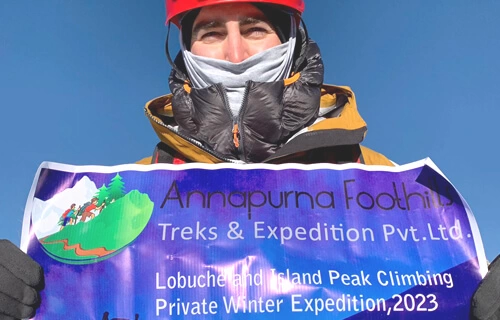About Three High Passes and Island Peak Climbing
There are several approaches to ascending Island Peak. Still, Annapurna Foothills Treks & Expedition highly recommends doing Three High Passes before attempting Island Peak, 6189m, as this itinerary will provide the ultimate pre-acclimatization. After crossing the Everest Three High Passes in the Khumbu region, Renjo La Pass, 5430m, Cho La Pass, 5330m, and Kongma La Pass, 5535m, you will be physically and psychologically prepared to climb Island Peak in Nepal. Completing the Khumbu Three High Passes Trekking in itself is a challenging yet enriching experience in the Khumbu Himalaya of Nepal.
Island Peak is a perfect choice for trekkers who are fit and ready to do something more than a challenging trek. Island Peak, also known as Imja Tse, lies south of Mount Everest like an island rising from valleys on all sides. We start our adventure with a mountain flight to Lukla, where we meet up with our crew. We hike up the Dudh Koshi Valley on the well-worn Everest trail while enjoying the soaring peaks of Thamserku and Kusum Kanguru. We reach Namche Bazaar, the commercial hub of the Khumbu region. This is a great place to stop and acclimatize, with great options for day hikes to nearby villages.
Instead of taking the busy trail toward Everest Base Camp, we head off into the Bhote Koshi Valley to Thame. This is a lovely cultural experience as the villages on this old trading route with Tibet are less commercialized and more authentic. We branch off this trail and climb toward the Renjo La, 5430m, and then down to the beautiful Gokyo valley, with its lovely turquoise lakes beside the moraines of Ngozumpa Glacier. We will climb Gokyo Ri, 5357m, to witness a spellbinding view of the region's 8000-meter peaks, including Everest, Lhotse, Makalu and Cho, before we cross the glacier and head toward Cho La, 5300m; we then join the Everest Base Camp Trekking trail nearby Thukla village.
After reaching Everest Base Camp, we climb the famous Kala Pathar for another astonishing panorama of Everest and its surrounding peaks. We then return to Lobuche, taking the trail to the Kongma glacier. By this time, we feel well acclimatized to head up to Kongma La, 5535m, our last pass before we attempt Island Peak from Chhukung.
At Chukung, our Climbing Sherpa will provide training in climbing techniques to ensure you are completely confident before you begin the climb. We spend one night at Island Peak Base Camp before our summit push.
The trail climbs up the tricky rocky section before reaching Crampon Point. We put on our harnesses, climbing boots, and other climbing gear. We walk through the ladders and cross the crevasse section before getting to the base of the famous ice headwall. A 300-meter headwall of 45-degree snow slopes leads to the exposed summit ridge of Island Peak. The view from the summit is just magical; one of the best views you can witness in the entire Khumbu region. We then carefully descend back to base camp and trek back to Chhukung. We start our trek back to Namche with great accomplishment and feeling strong for all our system's extra red blood cells. The next day, we catch our flight from Lukla to Kathmandu.
The best season for Three High Passes and Island Peak Climbing is from March to May (Spring) and September to November (Autumn). However, the winter is also a great time to climb if you are well prepared for the cold weather. In the crisp and cold month of December, the views of the mountains are crystal clear, and there are fewer tourists around. The Three High Passes and Island Peak Climbing duration can be lengthened or shortened according to your preference. Annapurna Foothills Treks and Expedition will arrange every detail of your Three High Passes and Island Peak Expedition; lodge accommodation, food, and all the necessary climbing and camping equipment.
Guaranteed Departures. We are preparing for our 2025 and 2026 dates and groups for Three High Passes and Island Peak Expedition.
This is a fantastic opportunity to join fellow climbers and share the adventure of a lifetime in the majestic Khumbu Himalayas. Take advantage of this unique chance to reach the summit of the highest trekking peak in the region.
touch for further details, book your spot and experience the adventure of a lifetime with Annapurna Foothills Treks & Expedition.
Similar Trip You May Like
- Climb Island Peak and Gokyo Cho La Pass in 18 days! Fewer people do this trek than Everest Base Camp. Prices start at $2350 per person.



















